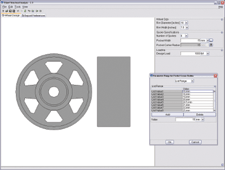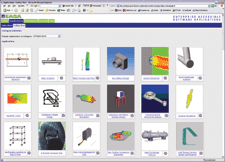Automate Your Analysis
EASA enables engineering companies to automate analysis, spreading best practicesand knowledge throughout the enterprise and improving ROI.
Latest News
November 1, 2004
By Sebastian Dewhurst
Through the application of analytical tools over the last 10 to 15 years, almostevery company in the manufacturing sector has improved key metrics such as timeto market, product quality, and manufacturing costs. However, a considerable amountof time and effort is often required to complete a given process involving oneor more tools such as MCAD, FEA, CFD, and even in-house codes and spreadsheets.In addition, employees capable of using these tools proficiently usually havelimited availability—like every other employee, they tend to be busy people.
The first observation suggests that companies could save a significant amountof time and money if they could automate some of the processes involving analysistools. The second observation regarding the availability of experts suggests thatsimply automating a given process using existing technologies such as scriptsand macros is not optimal. What is required is a method that easily automatesand deploys the analysis process in such a way that others in the organizationcan safely execute it. EASA—Enterprise Accessible Software Applications—can helpcompanies overcome both of these issues. Here’s how.
 Figure 1 (left) shows how an EASA application automatically creates custom reportssummarizing essential results. EASA archives reports into a central repository.
Figure 1 (left) shows how an EASA application automatically creates custom reportssummarizing essential results. EASA archives reports into a central repository.
A Corporate Toolbox of Expertise
Process experts are those who know how to execute a design process using analysistools. A process may consist of one step or several steps, each of which may involvetools such as analysis software, databases, in-house codes, or commercial packages.EASA provides a quick and easy way for these experts to author custom web-enabledapplications that automate and simplify the execution of an entire process.
Application authors do not have to write any code. EASA’s graphical applicationbuilder lets authors create a user interface that links to underlying softwareapplications and creates a custom report. This eliminates complicated and time-consumingcoding, and authors can create new custom applications in a few hours.
A typical EASA custom application created in this way offers a tab-, tree-, orwizard-based interface that leads users through the data entry process, as shownin Figure 2 (below). The application automatically generates the custom reportin HTML and print-ready PDF formats, and archives the report in a central repository(see Figure 1, above).
Since EASA applications are custom-made, they are specific to your company’sprocesses. EASA applications provide graphical user interfaces that encapsulatethe knowledge of your company’s experts. This results in a library of intranet-availableapplications—a sort of corporate toolbox that gives authorized users throughoutthe enterprise fool-proof access to your company’s processes, best practices,expertise, and software assets (see Figure 3, below).
Example Process
The table below exhibits a typical process executed 60 to 100 times annuallyand costing the company up to 250 man-hours per year. Because key experts arenot always available to perform the tasks, the elapsed time to deliver a finalreport often can stretch into weeks.
In contrast, once automated with EASA, this same process is executable by anyauthorized user, regardless of geographical location and the existence of theunderlying MCAD and FEA packages on their local machine. The EASA applicationenables the user to select the appropriate options and dimensions in less thanone minute of man-time, eliminating time wasted waiting for the MCAD specialistor FEA expert to become available. The elapsed time to report delivery is nowdetermined solely by the amount of CPU time required by the FEA analysis. CPUtime associated with the automated MCAD and report steps is negligible.
The amount of time saved scales with the number of processes automated in thisway, so a company can save many thousands of man-hours per year.
 Figure 2 (left): A typical EASA application allows the user to drive almost anyanalysis tool via a custom browser-based interface. Less than expert users canselect only valid options that have been predefined by the application’s author.
Figure 2 (left): A typical EASA application allows the user to drive almost anyanalysis tool via a custom browser-based interface. Less than expert users canselect only valid options that have been predefined by the application’s author.
Case Study
Steelmaker Corus uses EASA to provide its engineers with access to various analyticaltools that enable them to scrutinize the steel-making process closely. Beforeautomation with EASA, the use of such tools was limited to analytical expertswith extensive training. Corus’s analysis experts used EASA to create simple web-basedapplications to provide company-wide access to various models. These applicationsenable people who have never used the underlying analysis tools to generate anduse simulation results. Additionally, these applications include several logicalchecks to ensure that simulation results presented to the inexperienced user arecorrect.
Tim Peeter and Rene Duursma of Corus Research comment: “These models allow engineersoutside research and development to carry out heat transfer analysis, compositionalchemistry calculations, and metal weight requirements forecasts based on finalproduct specifications. This leaves our experts free to act as advisors and toperform new model development and be truly innovative, rather than acting as internalconsultants.”
 Figure 3 (left): The corporate tool-box is a library of applications that givesauthorized users access to processes, best practices, expertise, and softwareassets.
Figure 3 (left): The corporate tool-box is a library of applications that givesauthorized users access to processes, best practices, expertise, and softwareassets.
The Bottom Line
EASA also includes the ability to incorporate 2D and 3D dynamic engineering graphics,letting you encapsulate best practices and standards into your custom applications.In addition, your company’s sophisticated software tools, previously only availableto a small group of experts, can now be put to use throughout the organization.Because EASA automates and deploys processes to those who need the resulting information,experts typically experience a workload reduction. This, in turn, frees your expertsto focus on innovation rather than repeatedly executing multi-step, time-consumingprocesses.
EASA authoring of web-based applications that capture your company’s key engineeringprocesses and analysis expertise can save a significant amount of time and money.
Sebastian Dewhurst is president and CEO of EASA Software and Services. Send your comments aboutthis article through e-mail c/o [email protected].
This table summarizes a typical process that a company might execute 60 to 100times a year. Without automation, this process would cost a company as much as250 man-hours per year. | ||
Task | Person | Man-time |
Existing design edited within MCAD package to create new design | CAD expert | 0.2 - 0.5 hr |
New design imported into FEA package and boundary conditions applied | FEA expert | 0.3 - 1.0 hr |
Key data extracted from FEA results file and standard report produced | FEA expert | 1.0 hr |
Product Information
EASA Software and Services
easa.aeat.com
Subscribe to our FREE magazine, FREE email newsletters or both!
Latest News
About the Author
DE’s editors contribute news and new product announcements to Digital Engineering.
Press releases may be sent to them via [email protected].






